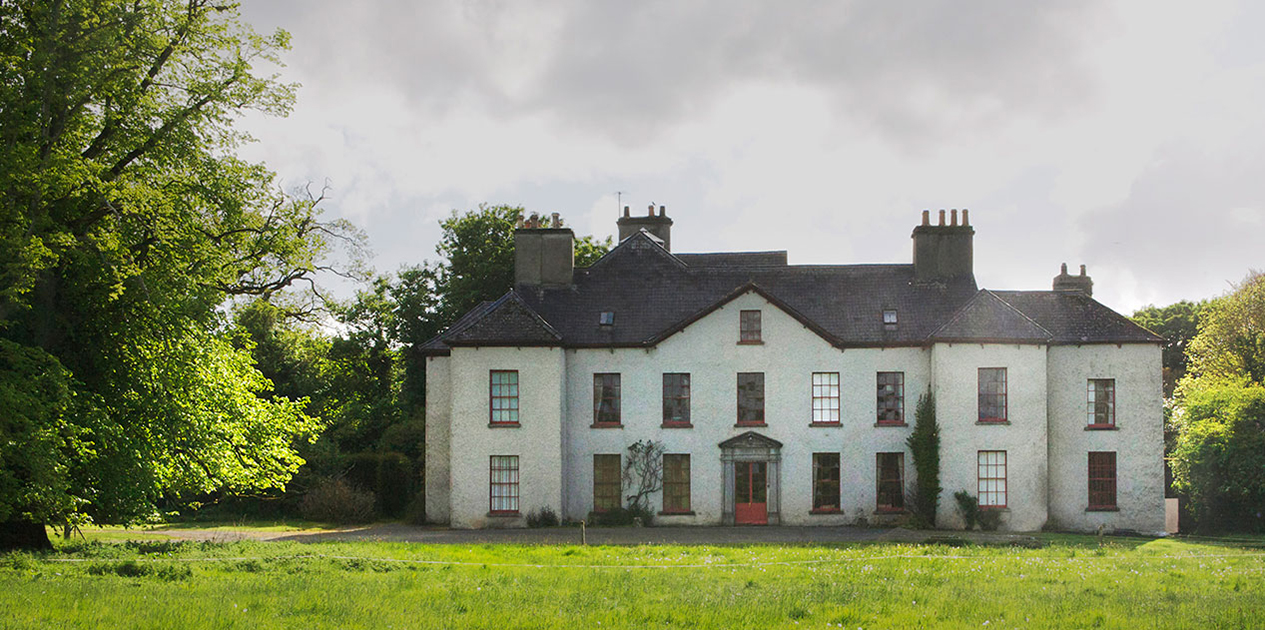Ballykilcavan
Ballykilcavan is a charming house of c. 1680 near Stradbally in County Laois, in heavily wooded parkland near the road to Athy in County Kildare. Reworked several times over the centuries the house retains its late seventeenth century appearance and is still occupied by the descendants of its original owners who came here early in that century. The mid-nineteenth century owner, Sir Hunt Johnson-Walsh employed William Robinson, "a promising local man'" who subsequently became the doyen of Victorian garden designers, influencing a whole school of gardeners by his naturalistic ‘Robinsonian’ plantings.
The estate was acquired in 1639 by Oliver Walsh, from a family long established in County Kilkenny where they rejoiced in the title of Walsh, Lord of the Mountain. Ballykilcavan was probably begun by his son, another Oliver, who died in 1697. The house has full-height wings like flanking towers at the corners of the entrance front while similar towers at the rear of the house are hidden by later extensions. A feature of semi-fortified 17th century houses, these towers lingered on into the early eighteenth century as decoration.
Ballykilcavan consists of a ground floor (unusually just above ground level), an upper floor and an attic storey, where today the dormer windows have been replaced by skylights. Altered and extended many times over the centuries many rooms retrain their late-seventeenth century dimensions, albeit with later decorations. In the mid 18th century Ballykilcavan was given a more Georgian aspect with a ‘floating’ pediment-gable, a fine cut-stone door case and sash windows with thin glazing bars. There is good 1730s plasterwork on the hall ceiling, and even finer work above the staircase and landing, which is actually the house’s finest room and originally extended from front to back as a gallery before the main staircase was installed.
The first member of the family to achieve prominence was Hunt Walsh, who commanded the 28th of Foot at the siege of Quebec and became a general. He was awarded a valuable estate in Prince Edward Island in a lottery of lands after the Seven Years’ War before succeeding his uncle at Ballykilcavan and becoming MP for Maryborough. General Walsh is likely to have commissioned the magnificent 18th century U-shaped stable block. The next owner was the general’s brother Raphael, Dean of Dromore, who began an ambitious remodelling including a new facade at the rear with a classical cornice and parapet, and a suite of south-facing rooms. Unfortunately, work was disrupted by the 1798 Rebellion so he only managed to complete one side of the building, leaving the remainder blank. This provides a single very large drawing room, entered at the half level from the staircase, with a pair of bedrooms overhead. The drawing room is particularly beautiful, with fine late-eighteenth century woodwork, mahogany doors and a finely modelled cornice.
Dean Walsh was succeeded by his sister’s son, a baronet who assumed the name Johnson-Walsh and the estate passed in turn to his two sons. The second Sir Hunt, Rector of Stradbally, was a keen gardener and built a tunnel to his walled garden at the far side of the Stradbally-Athy road. According to family legend his gardener, William Robinson, doused the hot-house fires before quitting his position on a particularly cold winter’s night. Nobody noticed his absence and, by the time the fires were re-lit, precious plants had perished.
The 1700s layout and avenues were rearranged in the nineteenth century when a new road was built from Stradbally to Athy. A distant section of this road is now on axis with the front door, and acts almost as a continuation avenue with the spire of St. Peter’s First Fruits Church as an eye-catcher in distance. Much of the estate is given over to native woodland, with some spectacular specimen oak trees and Spanish chestnuts, and the record Irish black walnut.
Sir Hunt was succeeded by his son and grandson, whose only child Oonagh married a neighbour, William Kemmis of Shaen. They subsequently changed their name to Walsh-Kemmis and their grandson, David, and his wife Lisa, are the 13th generation to live at Ballykilcavan.
Address & Contact
Ballykilcavan, Stradbally, Laoist: +353 57 8625143
Available as a Film Location


